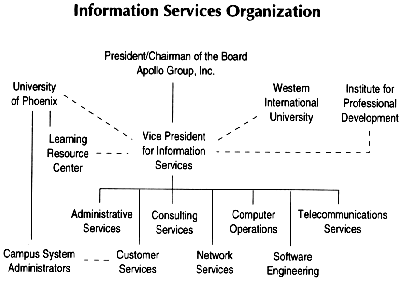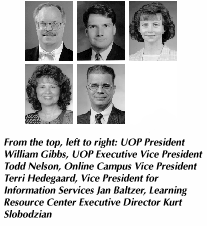
Copyright 1996 CAUSE. From CAUSE/EFFECT Volume 19, Number 3, Fall 1996, pp. 28-31. Permission to copy or disseminate all or part of this material is granted provided that the copies are not made or distributed for commercial advantage, the CAUSE copyright and its date appear, and notice is given that copying is by permission of CAUSE, the association for managing and using information resources in higher education. To disseminate otherwise, or to republish, requires written permission. For further information, contact Julia Rudy at CAUSE, 4840 Pearl East Circle, Suite 302E, Boulder, CO 80301 USA; 303-939-0308; e-mail: [email protected]

The University of Phoenix (UOP) was founded twenty years ago in Phoenix, Arizona, as a private, for-profit higher education institution whose mission is to provide high quality adult education (students must be 23 years of age or older and employed to qualify for admission). Accredited in 1978 by the North Central Association of Colleges and Schools, UOP currently enrolls 31,000 students and employs approximately 4,000 faculty. The University offers undergraduate degrees in business, management, information systems, nursing, and accounting, and graduate programs in business, management, nursing, education, counseling, and computer information systems.
Through innovative methods, including distance education technologies, the University offers educational access to working adults regardless of their geographical location. Programs are offered at physical campuses and learning centers in Arizona, California, Colorado, Florida, Hawaii, Louisiana, Michigan, Nevada, New Mexico, Utah, and the Commonwealth of Puerto Rico. Degrees are also offered through distance education programs to more than 3,100 students in all fifty U.S. states and abroad, using the directed study and teleconferencing options of UOP's Center for Distance Education or enrolling through the Online Campus.
UOP is one of three major subsidiaries owned and operated by
Apollo Group, Inc., a for-profit higher education corporation
also headquartered in Phoenix. The other two are the recently
acquired Western International University and the Institute
for Professional Development (IPD).1
Technology--A Strategic Resource
The University of Phoenix is unique in its focus on
delivering higher education to working adults, using a highly
interactive and experience-based educational model (see
sidebar, facing page). To the extent that technology supports
that focus and educational model, it is viewed as a valuable
strategic resource in which UOP is willing to make major
investments. All technology acquisitions and applications are
directed at solving a business problem or enabling a better
way of doing business, as well as supporting the teaching and
learning model. Thus, proposed technology investments are
accompanied by cost/benefit analyses, a significant component
of the planning and budgeting process.
Planning at the University is very much driven by the goal of growth within the framework of continuing to offer quality adult education. Technology is seen as making a major contribution to both of these ends; according to UOP President William Gibbs, "If we want to keep growing and improving our programs, technology must continue to be a significant resource for the University."
Debra Kelin, vice president of the University's Mountain Region, describes technology as a "tool to help us achieve three areas of importance to the University: quality, knowledge, and innovation." At the Colorado Campus, an Information Systems Advisory Committee has been charged with envisioning the campus's future in the Information Age and proposing appropriate technology investments to enable that future. According to Todd Nelson, UOP's executive vice president, while many functions of the University are decentralized to the campuses, there are nonetheless a number of key functions that are highly centralized, and for which effective information systems are critical. "Every problem we have, we try to address with a technology-based solution. There is without doubt a concerted strategy for significant investment in information technology to enable greater efficiencies and cost savings. From the top down and bottom up there has to exist a mentality that you are willing to spend money to be more effective. Then you need the money to do this. We've been fortunate in that we have a corporate culture that embraces technology as a solution to the future, and because we are a successful for-profit enterprise, we also have the resources to invest in the technology."
Tony Digiovanni, vice president of the UOP's California Region, agrees: "Being a for-profit institution is an advantage, as it keeps us extremely accountable. It forces us to watch the economic trends, to see how the technology continues to go down the cost curve, to know when to jump on board. As we look at the critical mass in the major population areas, while at the same time having a mission to provide access wherever students have needs, emerging network and communications technologies make a lot of sense for us to help maintain the University's growth."


An Information Services Steering Committee at the corporate
level serves as an advisory board to Information Services,
capturing input from the president of Apollo Group,
presidents of the three subsidiaries, Apollo Group's chief
financial officer, heads of the IS departments, directors of
major corporate departments, and several UOP regional vice
presidents. The committee focuses on a different topic at
each meeting, so in addition to the standing membership,
additional areas are represented, depending on the topic
under discussion.
According to Jan Baltzer, Apollo Group's new vice president for Information Services (IS), until last year the IS organization had been reactive, rather than proactive, in terms of meeting technology needs. But the creation last fall of her chief information officer position with a direct reporting relationship to Apollo Group's president enabled a total reorganization of Information Services and initiation of the strategic planning effort. With a more strategic and unified view, Baltzer says, "IS can focus on being 'out in front' of needs. We are much better positioned now to work with campuses in determining their technology needs and, in the process, help campuses plan for and budget for these investments." Nina Omelchenko, vice president for University Services at UOP, believes the creation of the CIO position and the consequent reorganization and refocusing of Information Services was a key decision: "It has made technology not just a tool, but a part of the strategic direction of the organization."
As part of the strategic planning process, Information Services staff created a mission statement and identified eight major goals and a series of tasks related to those goals within Apollo Group:
The new Information Services organization has seven units: consulting services, customer services, administrative services, software engineering, telecommunications services, network services, and computer operations. Director of Administrative Services John Lewis has worked closely with Apollo Group's human resources department in rewriting every job description and revising the organization's performance management system.
The new consulting services unit, in particular, will facilitate the goal of aligning technology with business needs. A major function of this unit is to consult with administrators at UOP campuses, Western International University, and IPD sites to help them determine how technology can be applied to solve their business challenges, as well as prepare them for technology that will be rolled out at the corporate level. Betty Maisel, director of this new unit, explains the importance of creating service level agreements: "In the past, IS has had conflicts with the campuses because of different levels of expectations; we haven't communicated very well. So managing expectations is a large part of what consulting services will be doing."
As part of this effort, a research and development function has also been created in IS. Once the consulting services unit has worked with the customer to identify business needs, R&D will work to find the best technology to meet those needs. Three new technology projects are currently under way: enterprise-wide electronic communications (new groupware products, such as Microsoft Exchange, for faculty and student interchange); a videoconferencing pilot in conjunction with the Salt Lake Campus; and wireless technology for use in the classroom to support such activities as recording student attendance.
A staff member within the central IS organization is responsible for assisting in the selection, training, and coordination of the work of Campus System Administrators (CSAs), who manage the information services functions on their campuses and serve as liaisons to IS.
The University purchased a system called Powerpages from UMI, and adapted it to the Internet for student access. A million articles are housed on 1,500 CD-ROMs that can be manipulated to deliver documents to students. UOP has a fully automated access point for students and can deliver full image, rather than full text, which Slobodzian thinks is more useful.
Students can do their own searches through the University's World Wide Web interface to the Center's online databases and CD-ROMS and automatically retrieve the articles, using fax- back delivery, or they can phone or fax in their search request and have professional librarians do the search and return the results. There is a charge for the assisted document delivery, but not for the searches or consultations. UOP has chosen to use fax as the delivery mechanism because of its mainstream properties--all students have access to facsimile technology, but many do not have the capability to download imaged documents for local printing.
Many UOP campuses have workstations connected to the Internet so students can access a service from EBSCO that provides full enhanced text. Slobodzian has also built a collection of links on the Web, a kind of "virtual" library collection aligned to UOP's programs and available to the public.
 In a time of stabilization for many higher education
institutions, why is the University of Phoenix experiencing
significant growth, both in terms of new campuses and numbers
of students? John G. Sperling, founder and president of
Apollo Group, Inc., the corporation that owns the University
of Phoenix, attributes much of their success to focus, and to
the application of a teaching and learning model that is very
attractive to working adults: "We specialize in delivering
higher education to working adults. For twenty years, we have
known our mission and not varied from it. We also saw the
demographic and social trends-an increasingly older, more
mature population in need of professional and continuing
education-and took aim at them. And from the beginning we
treated our students as customers. The most precious thing
working adults have is time, so we deliver education in a way
that recognizes that, and also recognizes and complements
their maturity, experience, and personal and professional
responsibilities."
In a time of stabilization for many higher education
institutions, why is the University of Phoenix experiencing
significant growth, both in terms of new campuses and numbers
of students? John G. Sperling, founder and president of
Apollo Group, Inc., the corporation that owns the University
of Phoenix, attributes much of their success to focus, and to
the application of a teaching and learning model that is very
attractive to working adults: "We specialize in delivering
higher education to working adults. For twenty years, we have
known our mission and not varied from it. We also saw the
demographic and social trends-an increasingly older, more
mature population in need of professional and continuing
education-and took aim at them. And from the beginning we
treated our students as customers. The most precious thing
working adults have is time, so we deliver education in a way
that recognizes that, and also recognizes and complements
their maturity, experience, and personal and professional
responsibilities."
Phrases such as student-centered learning, facilitated learning, lifelong learning, and learning outcomes and assessments have been part of the vocabulary of the University of Phoenix from its inception. These concepts reflect the philosophy on which it was founded, a philosophy responsible for the use of a teaching system in which lectures are minimized, and simulations, seminars, group discussions, and student work-related projects constitute the primary methods of learning.
Because the learning model also recognizes the importance of integrating theory and practice, the curriculum for each UOP degree program is designed by a task force of both faculty and industry professionals, and all courses are taught by working professionals with advanced degrees and current experience in the subject areas of their courses. The carefully planned curriculum identifies specific learning outcomes for each course, stated in terms of skills, competencies, and other performance-based measures, and a system is in place that enables consistent evaluation of both students and faculty.
 Ten years ago, when the University began to research the idea
of reaching students using electronic communications, it
found that some early research done by the Ontario Institute
for Studies in Education fit very closely with the teaching
and learning model already in use on UOP campuses. Computer-
mediated communications are very supportive of the highly
interactive environment that is the hallmark of a UOP degree-
-a teaching model that revolves around students sharing ideas
as opposed to students listening to a lecture. The University
realized that the facilitative nature of UOP's learning
system would actually be enhanced by the ability to be
asynchronous.
Ten years ago, when the University began to research the idea
of reaching students using electronic communications, it
found that some early research done by the Ontario Institute
for Studies in Education fit very closely with the teaching
and learning model already in use on UOP campuses. Computer-
mediated communications are very supportive of the highly
interactive environment that is the hallmark of a UOP degree-
-a teaching model that revolves around students sharing ideas
as opposed to students listening to a lecture. The University
realized that the facilitative nature of UOP's learning
system would actually be enhanced by the ability to be
asynchronous.
Thus in 1989 the University launched its Online Campus, succeeding in building a computer-based delivery system that provides interaction of the same quality as that found in its traditional face-to-face classrooms. According to Terri Hedegaard, vice president of the Online Campus, UOP wascareful to adopt only mainstream technologies to deliver online education. "We wanted a cost-effective and rugged system that would be accessible and cost-effective for students as well. We could get 'glitzier' but our primary evaluation criterion is, does it add value to the learning environment. That's why we aren't doing 'talking heads.'"
Currently, UOP is delivering online education using computers and modems and a computer conferencing system called Alex (Apollo Learning Exchange, based on a product from Convene). Students access Alex on a host system by calling direct via modem or through Internet service providers or other Internet gateways. As increasing numbers of students gain access to the World Wide Web, this will become a more universal resource for delivering online courses.
While classes that meet in physical locations have an average of sixteen students, the average online class size is eight because of the intensive nature of the online interaction.
More than 200 faculty are currently teaching online, with 50 in training. Faculty training is also intense, consisting of eight weeks of online training, followed by practice teaching and observation of an experienced faculty member teaching a course. The first time faculty teach an online course, a mentor is assigned to advise them and monitor their class. From start to finish, it takes about three months to train a faculty member.
For online students, the curriculum is the same, but oral presentation skills are not included in the outcomes sought. However, writing skills and online communication skills are greatly enhanced. Students enrolling in the Online Campus take a brief communication skills class before taking courses.
This article is based on a visit to the University of Phoenix headquarters by editor Julia Rudy. The magazine's Campus Profile department regularly focuses on the information resources environment-information, technology, and services- of a CAUSE member institution, to promote a better understanding of how information resources are organized, managed, planned for, and used in colleges and universities of various sizes and types.